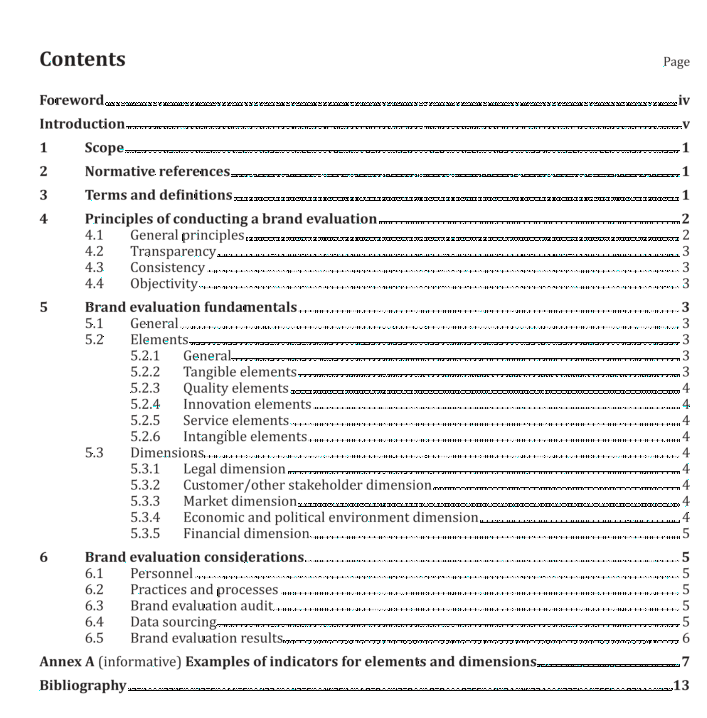ISO 20671 pdf download

ISO 20671 pdf download Brand evaluation — Principles and fundamentals
5.2.3Quality elements
Quality elements refer to resources allocated to quality commitment,quality management andperceived quality.Indicators of these elements include e.g.quality management system implementation,process documentation and qualified quality managers.
5.2.4 Innovation elements
lnnovation elements refer to resources allocated to innovation activities.Indicators of these elementsinclude e.g.innovation capability, sustainability and effectiveness.
5.2.5Service elements
Service elements refer to activities which aim to satisfy the needs of customers and enhance brandperception and engagement. Indicators of these elements include e.g. service capability and serviceeffectiveness.
5.2.6Intangible elements
Intangible elements refer to intellectual, strategic and cultural resources.Indicators of these elementsinclude e.g. history,heritage/tradition,brand positioning and personality,brand image, humanresources and knowledge management.
5.3Dimensions
5.3.1 Legal dimension
Legal dimension refers notably to the brand’s status of protection and the scope of brand rights andtheir ownership. Indicators of this dimension include e.g. assessments of trademarks,trade names,copyrights, patents, Internet domains,and other intellectual property related aspects.
5.3.2Customer/other stakeholder dimension
Customer/other stakeholder dimension refers to both, the psychological and behavioural perceptionand response.Other stakeholders also may play an important role in brand evaluation, such as e.g.employees, trade/ supply chain partners, investors, banks, government, media, community.
Indicators of this dimension include for example,. how customers/stakeholders think and feel about thebrand and how the discuss it in positive or negative ways, customer/stakeholder actions that reflectpositive or negative reactions.
These indicators often require direct measurement with customers through market research regardingthe functional, emotional, and/or experiential qualities associated with the brand.
5.3.3 Market dimension
Market dimension refers to the actual status of the market and opportunities for the development of abrand and the structural limitations that market conditions may impose.
Indicators of this dimension include for example,market size,number of competitors, strengthof competition,competitive innovation,distribution channels,the favourable or unfavourablemarket forces or trends that affect a brand due to specific market conditions,market potential andinternationality.
5.3.4 Economic and political environment dimension
Economic and political environment refers to the macro environment in which a brand is operating.This dimension includes the indicators of favourable or unfavourable external forces or events outside of the market itself. This includes for example, trade agreements and government monetary policiesthat may positively or negatively affect the performance of the brand.
5.3.5 Financial dimension
Financial dimension refers to the financial status and the financial potential of a brand. Thisinformation is often derived from profit and loss accounts and balance sheets or other financial reportsof companies,cities or regions. Indicators of this dimension include e.g.profits, cost savings, margins,income,brand investment,volatility,revenue,cash-flow,GDP,ROI and payback period, channelinvestments and risk rates.
6Brand evaluation considerations
6.1Personnel
A period of relevant professional experience for a qualified brand evaluation manager and qualifiedbrand evaluator is required before brand evaluators/managers and brand valuators independentlytake responsibility as specified in this document.
6.2Practices and processes
The brand evaluator is responsible to:
– ldentify the relevance of elements and dimensions, and monitor and measure their indicators.- ldentify which indicators are valid and which are not.
– Disclose the rationale for the selection of/exclusion of measurable indicators and their assembly.
Disclose the calculation of any specific formula used to calculate an indicator, and when appropriatea sensitivity analyses to the main parameters used in the evaluation models.
– ldentify the nature and frequency of monitoring and reporting of the indicators.一 Disclose the assumptions in case an indicator is prohibitive to measure.
– Describe the context in which the evaluation is carried out.
The entity shall retain appropriate documented information as evidence of the results.
6.3 Brand evaluation audit
A brand evaluation audit establishes or validates the minimum practices to conduct a brand evaluationfor a specific entity.The entity may conduct audits at planned intervals or as required.
A brand evaluation auditor confirms the integrity of the brand evaluation system, its compliance withthis document and/or reviews whether the brand evaluation practices of the entity are effectivelyimplemented and maintained.









